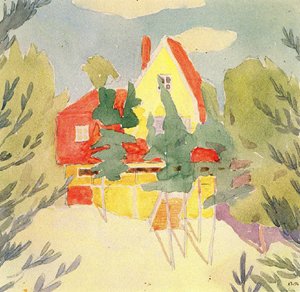
Nataliya Teramae writes a profile that captures the art and journey of Oleksandr Bohomazov (1880-1930) by focusing on his Finnish trip and how this came to play out in the artist's 'Finnish series'.
Oleksandr Bohomazov (1880-1930) is an acclaimed Ukrainian Avant-Garde artist, educator, and Cubo-Futurist theoretician. The art historian Andrei Nakov has compared him with key futurists Umberto Boccioni, Giacomo Balla, and Franz Marc. However, Bohomazov’s talent didn’t go through the melting pots of European art like Paris at the beginning of the 20th century. He was developing exclusively in Kyiv. Bohomazov in fact left Ukraine only three times: to study in Moscow for a year in 1907, for his travels to Finland in 1911 and when he worked in Armenia in 1915.
In this article I will focus on his Finnish trip, since it was de facto the only journey abroad. Though it took place exactly 110 years ago, ironically, this trip was not well-researched until recently. I have recreated the artist's trip in order to identify the locations he painted as well as describe the journey itself. What did he see? What inspired him? What was Finland like at that time? Bohomazov created his ‘Finnish series’ and left an archive of his correspondence from Finland. My research ‘Oleksandr Bohomazov. A Century Later’ is based on these materials as well as on interviews with local museum curators and historians. The project is supported by the Ukrainian Cultural Foundation.
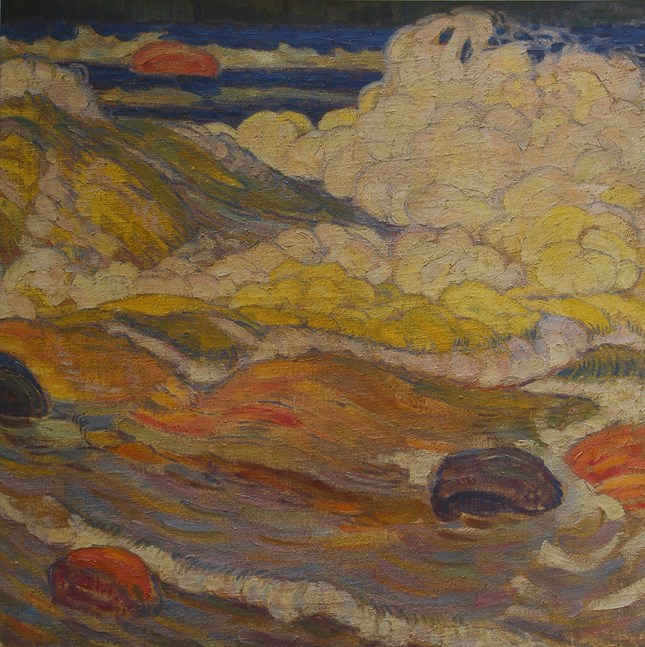 The sea waves
The sea waves
Creating Avant-Garde in Kyiv
Bohomazov’s path to art was not easy. Though his authoritarian father forced him to enter Kherson Agricultural School in southern Ukraine, Oleksandr couldn’t resist the desire to draw. ‘I am an artist. This is both my weakness and my strength. It’s not a whim, but a necessity, a sense of life. I ignored all other careers that could support my wellbeing’, - he later confessed at the age of 30.
After Kherson, the 22-year-old Bohomazov moved to Kyiv and entered Kyiv Art School. From his teachers Oleksandr Murashko and Mykola Pymonenko he received a solid academic education. However, his main influence came from classmates he was close to and was developing alongside, such as Aleksander Arhipenko and Aleksandra Exter. With the latter and David Burliuk, Bohomazov participated in important Avant-Garde exhibitions in Kyiv like ‘The Link’ (‘Lanka’, 1908) and ‘Circle’ (‘Kiltse’, 1914). Soon Bohomazov’s friends would leave Ukraine to settle abroad and become world renowned artists. Bohomazov would stay and develop his style at home.
Kyiv Art School was also a place where Bohomazov met his future wife Wanda Monastyrska. She was his muse and source of inspiration. After marrying her, Bohomazov wrote his theoretical work ‘Painting and Elements’ in 1914. In 1973 Andrei Nakov emotionally characterized it as ‘amazing’: ‘I have been working on Avant-Garde theory for years, but this is amazing!’ Unfortunately, WWI and the establishment of the Soviet state did not allow Bohomazov to present his work that was deemed as important as Malevych and Kandinsky.
Starting in 1914, Bohomazov created his prominent Cubo-Futurist and abstract paintings such as ‘Tram’, ‘Locomotive’, ‘Armenian Woman’, ‘Abstract Landscape’, and ‘Memory of the Caucasus’. When Jean Chauvelin saw ‘Tram’ he said: ‘I have travelled the length and breadth of the Soviet Union looking at Leftist art, and this is the best I have seen!’ Bohomazov was promoting a new art that would defeat the old one. The late 1910’s were highlighted by the speech he presented at the All-Ukrainian Artists’ Congress in 1918. The artist emphasized the urgent need to develop Ukrainian national painting. He stated that ‘it is not worth looking hopefully on Petersburg or Moscow’, where ‘previously talents were going’. But to give the young generation ‘the joy of being here, under the rays of our gracious sun’. Bohomazov taught his ideas and vision of art to students at the Kyiv Art Institute where he worked from 1922 until his death eight years later.
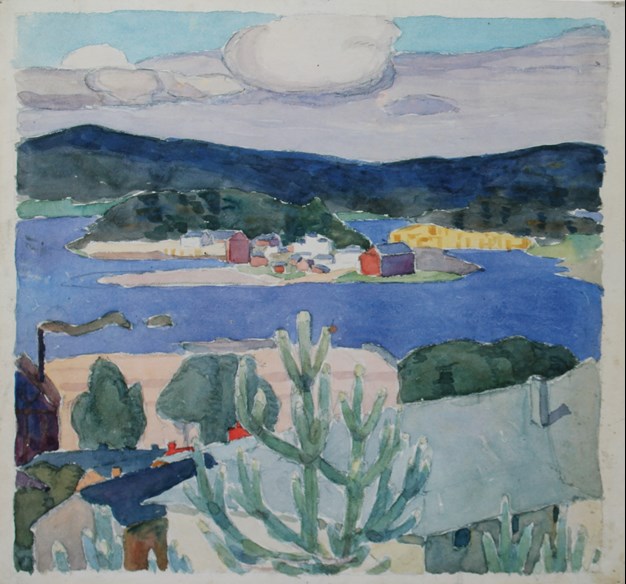 Finland Landscape
Finland Landscape
During his last years of life, the artist was working on the triptych ‘The Work of Sawyers’. He wanted to present the beauty and strength of labour and depict it with the help of sunny, distinct colours. It is important to mention that the subject of timber probably originally caught the artist's attention during his trip to Finland. This Nordic land was known for its wood exports and in his letters, Bohomazov described sawmills along Lake Saimaa’s shores in Lappeenranta.
One of the triptych paintings - ‘Sawyers’ - was exhibited at the Venice biennale in 1930. The artist had died a couple weeks before from tuberculosis from which he had been suffering since the early 1920’s. Bohomazov was not studied in the Soviet Union. He was labelled as ‘formalist’ and his paintings in the Art Museum in Kyiv were subject to destruction. Bohomazov’s legacy was preserved by his wife Wanda. The first art historian who started to talk about and study Bohomazov was Dmytro Horbachov. He was the one who introduced Wanda and Bohomazov’s works to French art historians. The first Bogomazov exhibition abroad took place at the Museum of Modern Art in Toulouse in 1991. Nowadays the artist is promoted by Professor Emeritus of Art History Myroslava Mudrak, and art collectors Eduard Dymshyts and James Butterwick.
Summer side of Finland
It is said that in Finland Bohomazov was inspired by the local ‘Scandinavian Art Nouveau’ though, that is not entirely the case. We know that he went to Finland on a business trip for ‘Kievskaya mysl’ (Kyiv Thought) newspaper. For years the artist was earning a living working as its caricaturist and illustrator. Why Finland? At that time, Ukrainian artists were travelling to study art in Italy, France, Munich, Vienna or Warsaw. However, there was nothing like that in Finland, especially in the eastern part where Bohomazov was travelling.
That area was a popular tourist destination within the Russian empire, particularly among merchants, nobles, and artists. It was a part of the same state, but on the other hand kind of abroad. It had a different language, mentality, and some unique landscapes such as the grand Lake Saimaa or the rapids near Imatra. Ironically, in the 1910’s the area was more popular among Russian artists than Finnish, says Eero Laajo, curator of the Imatra Art Museum. Anna Ostroumova-Lebedeva, Nikolai Roerich, and Wassily Kandinsky visited the region for vacations and for work. ‘It was more popular among Russian artists because of the Russian tourists. The situation changed when Finland became independent in 1917’, - explained Laajo.
For a month and a half, from June to August, Bohomazov was following the tourist route Imatra-Lappeenranta-Vyborg-Punkaharju-Savonlinna. He created dozens of paintings, watercolours, and inks during his trip. The exact number is not known. ‘It was not calculated by the family, – said Tatiana Popova, artist and granddaughter of Bohomazov. – Until Brezhnev’s Thaw everything was kept in rolls in a big box’. Nowadays, the Finnish cycle is spread out among private collectors and Ukrainian museums. Unfortunately, a lot of them carry titles that don’t easily identify their locations.
During his visit to Imatra the artist painted two oils of the local architectural gem - Grand Hotel de Cascade (now Valtionhotelli). They are ‘The Tower’ (NAMU) and ‘A Castle in Finland’ (collection of Konstantin Grigorishin). The hotel was built in the Art Nouveau style and in the form of a castle, partially reminiscent of Olavinlinna fortress situated on the other side of Lake Saimaa.
Another must-see in Imatra were the rapids – Imatrankoski and Vallinkoski. They were so popular that famous foreigners and nobles were coming to witness the natural miracle. Among them were Alexandre Dumas père, Richard Wagner and Pedro II of Brazil. Bohomazov was fond of the rapids. ‘A few days ago I was painting Little Imatra (Another name for Vallinkoski. – Author) in oil. Painting easily, freely, with joy. I have completed a canvas. I was happy!’, - he reported to his fiancée Wanda in a letter. Here he talks about painting ‘The Sea Waves’ (NAMU). There is also a series of watercolours picturing the rapids – ‘Stream and Rocks. (Istra River-І)’ (NAMU), ‘Wave. (Istra River-ІІ)’ (NAMU), ‘Waves and Rocks. (Istra River-ІІІ)’ (NAMU), ‘Istra River (Finnish waters)’ (private collection), ‘Stormy River’ (collection of Konstantin Grigorishin).
Finland is well-known for its lakes. Among them Saimaa is a real gem. It is the largest lake in the country and one of the largest in Europe. Moreover, its island-dotted landscape makes it unique. Bohomazov was very excited to explore Saimaa as an artist. ‘With greedy curiosity I was looking around and was astonished by the variety of nuances: now, the lake is wild and harsh with gloomy inhospitable islands, now, charming with its tenderness, inviting with promises of caress! And all these changes are created by the sky, to which Saimaa is so sensitive!’, - wrote Bohomazov.
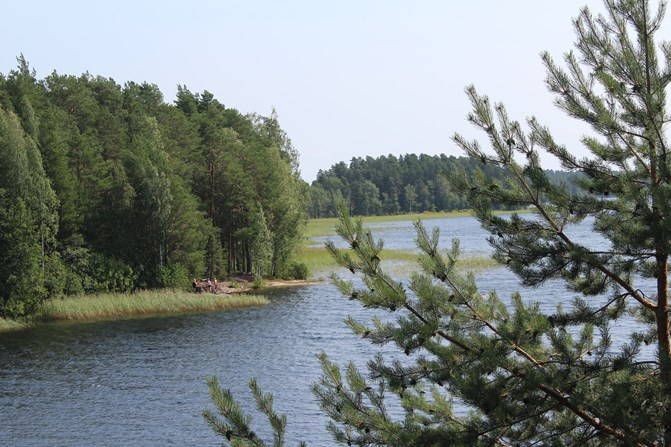 Punkaharju Today
Punkaharju Today
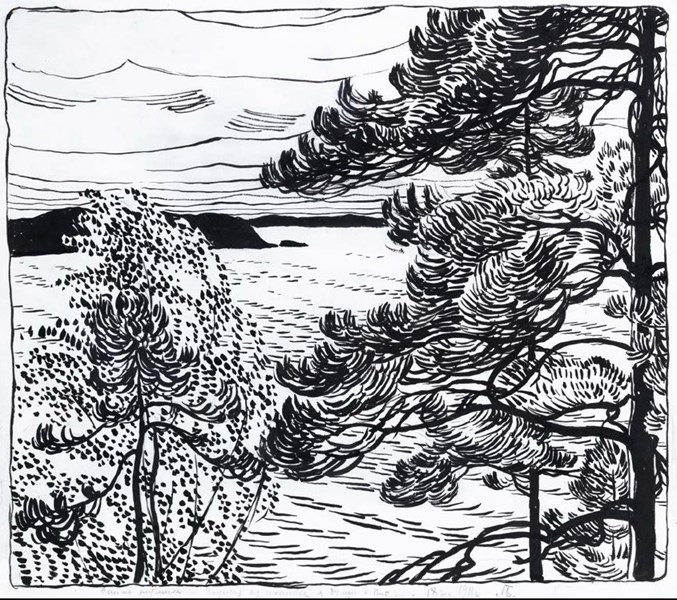 Finnish Landscape
Finnish Landscape
He painted Saimaa in two watercolours at his next destination – Lappeenranta. These works are entitled ‘Finland’ (NAMU) and ‘Finland. Landscape’ (NAMU). The first one is the view from the town hill over Saimaa and Pikisaari island. It looks exactly like the landscape in the photograph ‘Wilmanstrand. Finland’ taken between 1905-1915 by the well-known Russian photographer Sergei Prokudin-Gorski. Another watercolour is probably the view from the island over the sawmill as there is a wagon and station visible in the picture. The station is still there.
The beginning of the 20th century in Finland was marked by national awakening, both politically and culturally. Writers and artists searched for inspiration and authentic national spirit in Karelia, where the national folk epic ‘Kalevala’ was recorded. Consciously or subconsciously, Bohomazov did the same. In Vyborg he painted ‘Väinämöinen playing kantele’. Väinämöinen is the key character of ‘Kalevala’. It is very likely that he made two additional works there – watercolour ‘Landscape with a Red-Roofed House’ (collection of Konstantin Grigorishin) and ink ‘Finland’ (NAMU). In his letter from Vyborg he was describing the former, ‘the red tone of the whole building surprisingly softly and calmly, but at the same time brightly, vibrates with the evening sky. The windows glow and shimmer from yellow-orange to a dark blue-green tone’. The latter work depicts ‘pyramidal haystacks lined up in regular rows basking in the last rays of sunshine on a green lawn in the distance’. In Vyborg he recalled Boyarka, a summer cottage village near Kyiv, which was one of his favourite subjects.
Nature was another source of inspiration for the national awakening. Thanks to the Finnish writers Johan Ludvig Runeberg and Zacharias Topelius, the ridge of Punkaharju on Saimaa was chosen as the true national landscape. Bohomazov, however, didn’t see the place as something special and left Punkaharju disappointed. It seems though he captured its views in the inks ‘Finnish Landscape. The Sound of Saima’ (collection of Eduard Dymshyts) and ‘Lake’ (NAMU).
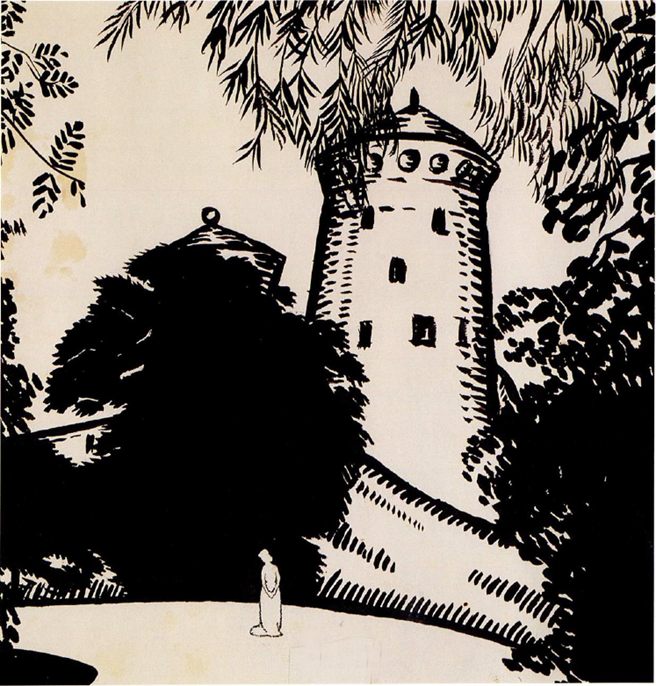 Woman's Silhouette with Castle Background
Woman's Silhouette with Castle Background
Studying Bohomazov’s letters and paintings, one won’t find traits of the Scandinavian Art Nouveau, except for the exterior of Valtionhotelli. In practice, the artist admired Gothic architecture. He wrote about ‘Gothic buildings’ that attracted him in Vyborg. One of the key images he described both in his letters and pictures was a castle. There is one in Savonlinna, the last town he visited in Finland. It is called Olavinlinna and is pictured in the watercolour ‘Landscape with Red Houses’ and in the ink ‘Woman’s Silhouette with Castle Background’, both from Grigorishin’s collection. Another medieval image is in the picture ‘Finland. Cathedral’(NAMU) which depicts the Neo-Gothic Savonlinna Cathedral built in 1878.
The characteristics of a castle are also captured in the watercolour ‘Female Silhouette with Castle in the Background. Finland’ (collection of Eduard Dymshyts). Actually, it was a building of ‘Olavin kylpylaitos’ (Olav’s Baths), the first spa in Finland. Bohomazov tended to see Gothic elements in its towers. Unfortunately, the building was damaged by fire in the 1960’s.
At the beginning of his travels, Bohomazov reveals the main goal of his trip. He wrote from Imatra: ‘Awareness that my goal, my idea has brought me here, gives me the necessary peace, cheerfulness and joy. If someone took away my opportunity to work now and left here, I would not know how to kill, to quiet this newborn melancholy’. He followed his agenda stubbornly, even though he suffered from loneliness and nostalgia. The artist carefully studied the colours of the northern nature - green pine trees covered by the dove-coloured moss, changeable Saimaa, and the effects of the sun on various objects.
We can conclude that Bohomazov was pleased with the trip, and with himself, and fulfilled his desire to learn. ‘I thought there were few colors in the north. It turns out that there are so many. In this seeming monotony, there are many hints of color and distinct charms,’ he assumed by the end of the journey.
The author would like to thank Eero Laajo, curator of the Imatra Art Museum, Miikka Kurri, curator of the South Karelia Museum and Jyrki Paaskoski, an author and historian, for their help in the research.

ArtDependence Magazine is an international magazine covering all spheres of contemporary art, as well as modern and classical art.
ArtDependence features the latest art news, highlighting interviews with today’s most influential artists, galleries, curators, collectors, fair directors and individuals at the axis of the arts.
The magazine also covers series of articles and reviews on critical art events, new publications and other foremost happenings in the art world.
If you would like to submit events or editorial content to ArtDependence Magazine, please feel free to reach the magazine via the contact page.